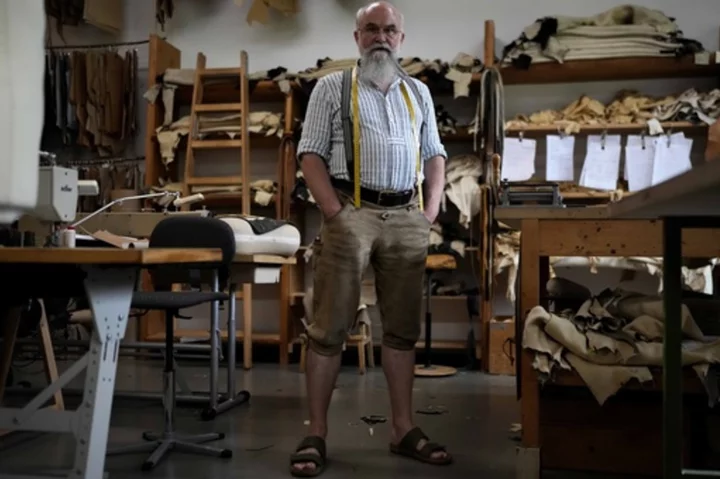BAD HINDELANG, Germany (AP) — As Germany’s city of Munich prepares to tap the kegs for Oktoberfest this weekend, Bavaria state residents and foreign regulars of the world’s most conspicuous beer party are getting ready to drink and celebrate while showing off their traditional lederhosen and dirndl dresses.
Bavarians have worn lederhosen — knee-long leather pants with suspenders and embroidery — for hundreds of years. They own everyday lederhosen and special pairs for weddings, harvest festivals and hunting season.
These days, lederhosen-style garments made in China are available online for less than 100 euros ($107). Revelers preferring a more classic look book an appointment with leather tailor Klaus Bensmann for customized, handmade britches fashioned from deer or cow leather.
Bensmann, 64, who wears metal-rimmed glasses and a Santa-Claus-like beard, has made leather pants for almost four decades in his workshop in Bad Hindelang, a small Bavarian village in the foothills of the Alps close to the Austrian border.
“If you want a pair of lederhosen in time for Oktoberfest, you have to come to me at least half a year in advance, in the winter, so I can measure everything, get to work and finish it in time,” the tailor said during an interview with The Associated Press on Thursday.
Bensmann does things the old-school way. He collects deer skins from hunters in his region and personally takes them to a tanner in eastern Germany's Saxony state, where they are treated with blubber from codfish and herring, milled and dyed in the colors he requests.
Bensmann offers different cuts of Bavarian lederhosen, traditional knee-longs, short ones that end mid-thigh and longer, looser knickerbockers.
He grew up on a farm in North Rhine–Westphalia state's Muensterland region, hundreds of kilometers northwest of Bavaria, so he did not grow up wearing the leather pants like some country boys in southern Germany still do.
Bensmann found his future calling after finishing high school, when he and his wife spent a year in Canada. He says an old trapper there taught him the Indigenous method of making buckskin leather by soaking hides in animal brains and tanning them using wood smoke.
“This year in Canada was a crucial experience for me,” he said, adding it was when he realized that working with leather was what he wanted to do in life.
When he returned to Germany, he searched all over the country for a traditional tanner who could teach him the craft and found one in Bad Hindelang, where Bensmann still lives today.
But instead of working as a tanner, he decided to become a leather tailor, and in 1985 he opened his store and workshop, Leder Bensmann.
“It took the Bavarians a while to accept an outsider from a far-away place like the Muensterland as one of their own,” he said with a laugh. By now, the locals trust him enough to make their lederhosen.
His shop is a one-man operation, but Bensmann's wife helps out and he employs two women to artfully stitch flowers and deer with antlers on the pants in mulberry silk yarn.
Bensmann won't reveal how many leather pants he produces every year, but he gladly shares how much one pair would cost: simple lederhosen for everyday use start at around 1,000 euros. The elaborately embroidered ones for occasions like Oktoberfest run 1,500-1,800 euros.
“Lederhosen have seen a revival in the last 10 years or so,” Bensmann said. “But at the same time, they never really went out of fashion, at least not in Bavaria.”
___
Grieshaber reported from Berlin.









